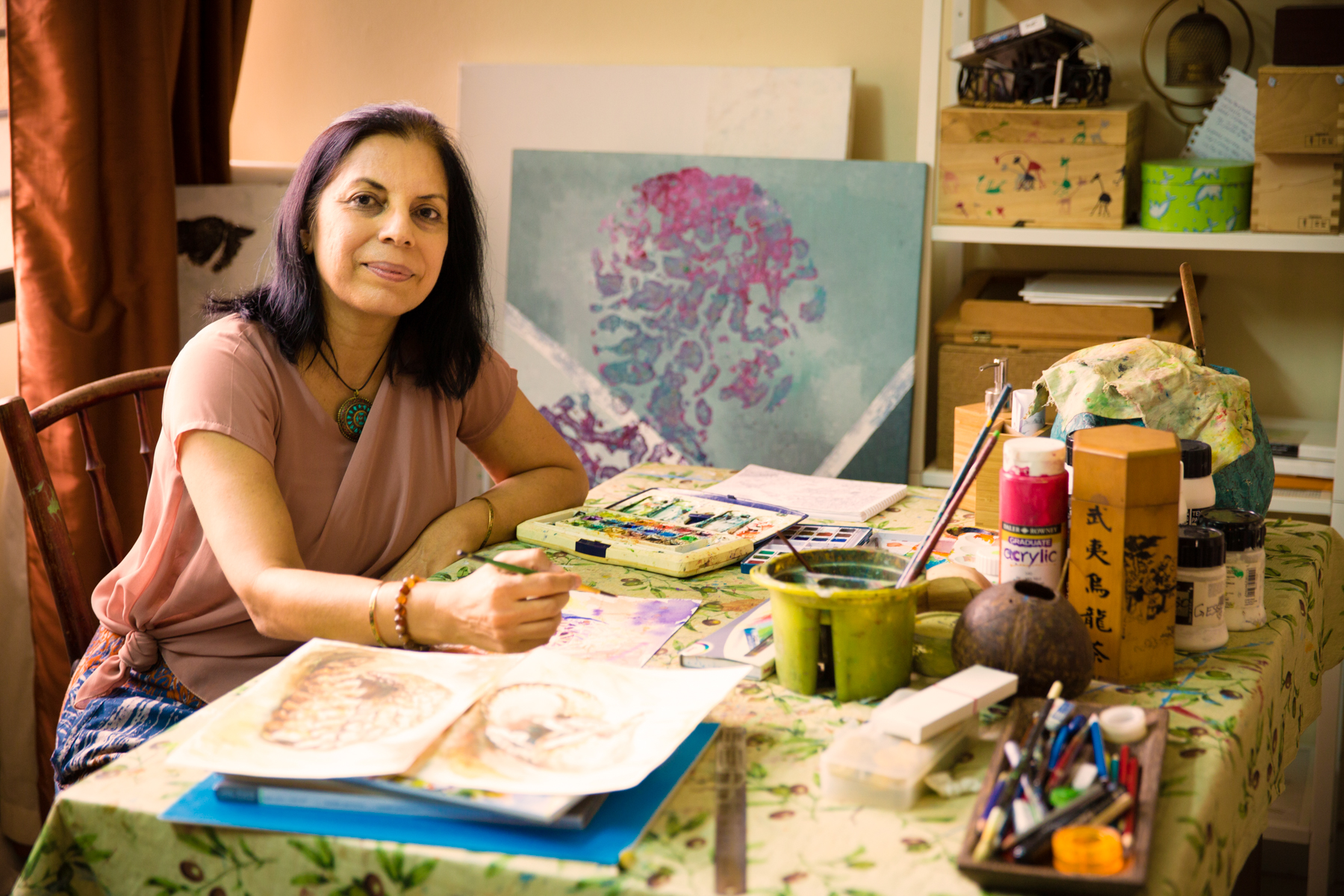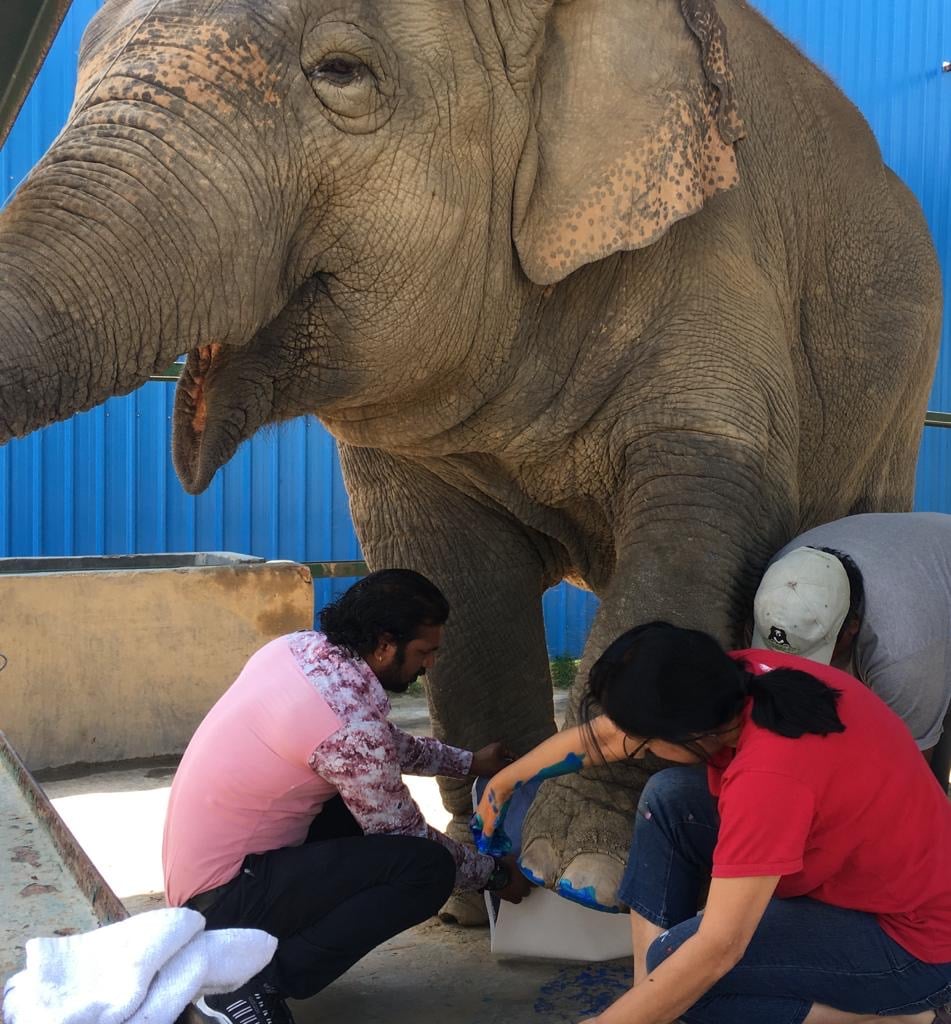by Damini Roy
Alpana just loves elephants. Her studio is filled with their portraits and their amazing pad prints. She smiles with joy recounting her experiences with large friends, in particular her favorite art co-creator Phoolkali.
The natural world is shrinking and, as it does, we find ourselves being drawn to connect to it in so many ways — from house plants to forest walks to our much loved domestic animal friends. As we increasingly urbanize, there is a counter desire to connect to something greater than ourselves that is the wonder of the natural world. It’s from this impulse that we have found our way to the Singapore studio of Alpana Ahuja.
Elephant Muse and Co-Creator
Alpana is an artist who involves animals, mostly elephants, in co-creating paintings, then uses the works to raise funds and awareness for animal rescue and conservation efforts.
Alpana’s life is a testimony to the adage: “A spark is all it takes to light change within and around.” After a chance encounter with the work that Wildlife SOS was doing at the Elephant Conservation and Care Center in Mathura, India, Alpana felt urged to become more involved.
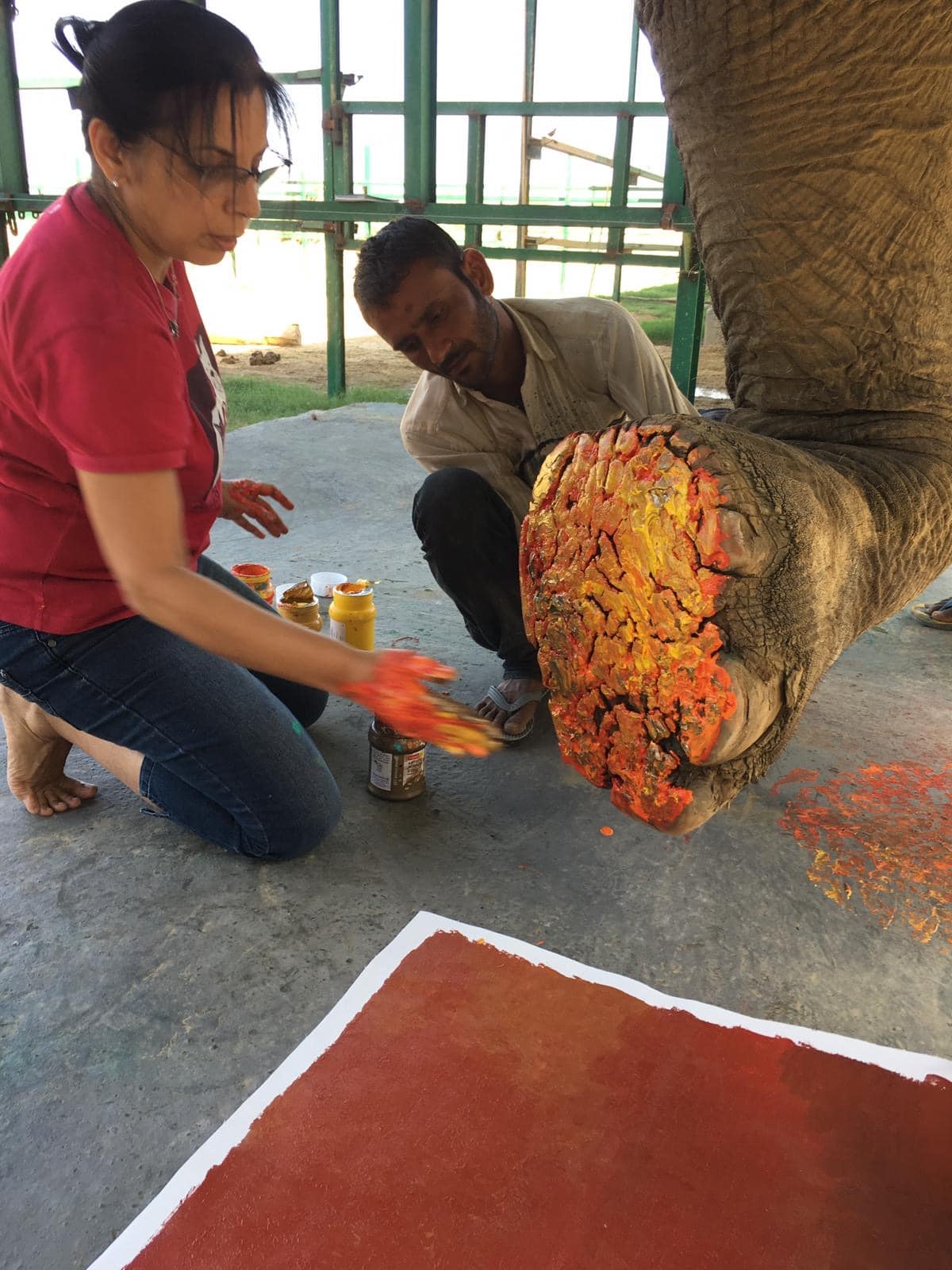
Intersection of Art and Wildlife Conservation
Her work is at the intersection of art and wildlife conservation. Over the years, her work has been widely collected by the likes of Pharrell Williams among others, and has helped raise thousands of dollars for wildlife conservation in India and Singapore.
“In a way, my life truly started after I turned 50. So far, the last seven years have been really rocking! I love and am grateful for every chance I’ve had to create and help the animals.”
From Ganesh to Elephant Paintings
AGEIST: There are a lot of images of elephants in your work. Is there something special about elephants?
Alpana: I had painted Ganesh (Indian elephant-headed God) for many years and then the elephants came into my life. I painted one, my first, for a calendar I was creating for Wildlife SOS. Then I painted more and more, in different mediums and different colors. I seemed to have found my muse. There were elephant paintings coming out of me very fast, and in a medium I had not worked much in: acrylic. I began to learn about their gentle natures, human-like emotions, deep knowledge of the earth and forest around them (which is passed down from the matriarch). I bonded with them, over food, of course, and mud!
At the sanctuary, elephants are picky about their friends and will make their own decisions on who they want to be with. They nurture the younger ones and are protective. As subjects, they are fascinating. They can be painted in abstract or realistically, in monotones or vibrant colors. I can zero in on a portion of the face or paint a whole herd. As a muse, the elephant is wonderful.
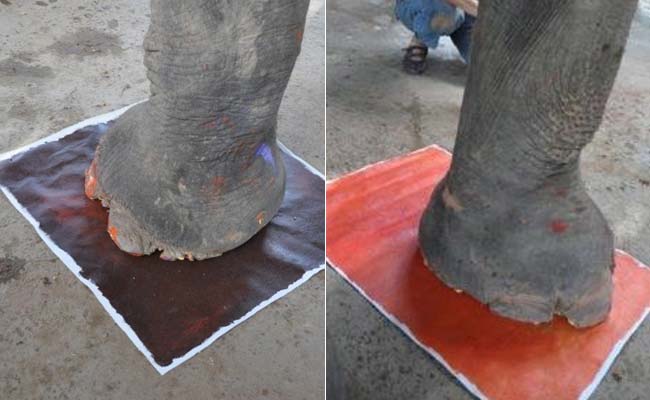
“No two elephants are the same”
I don’t find this versatility in any other animal. All other animals I paint are very realistic, but with the elephant, I seem to go beyond. I love how the sunlight creates shadows on them. There is so much character in the tilt of the head, so much emotion in the way they touch each other. The trunk has a finger-like tip, and they can pick a pea from my palm.
Just watching them play in the water, the dust, and the mud is divine. Their intelligence and human-like social relationships, and the abuse piled upon them makes me want to undo every evil that man has done to them.
They have very real personalities; no two elephants are the same, just like people. Even their footprints tell a story. The ‘Padhchinh’ collection, which are pad prints, raises funds for rescued elephants, and is an ongoing project. Once or twice every year I work with them and observe how their footpads have changed. New rescues have almost smooth footpads – all worn out by walking on tarred roads.
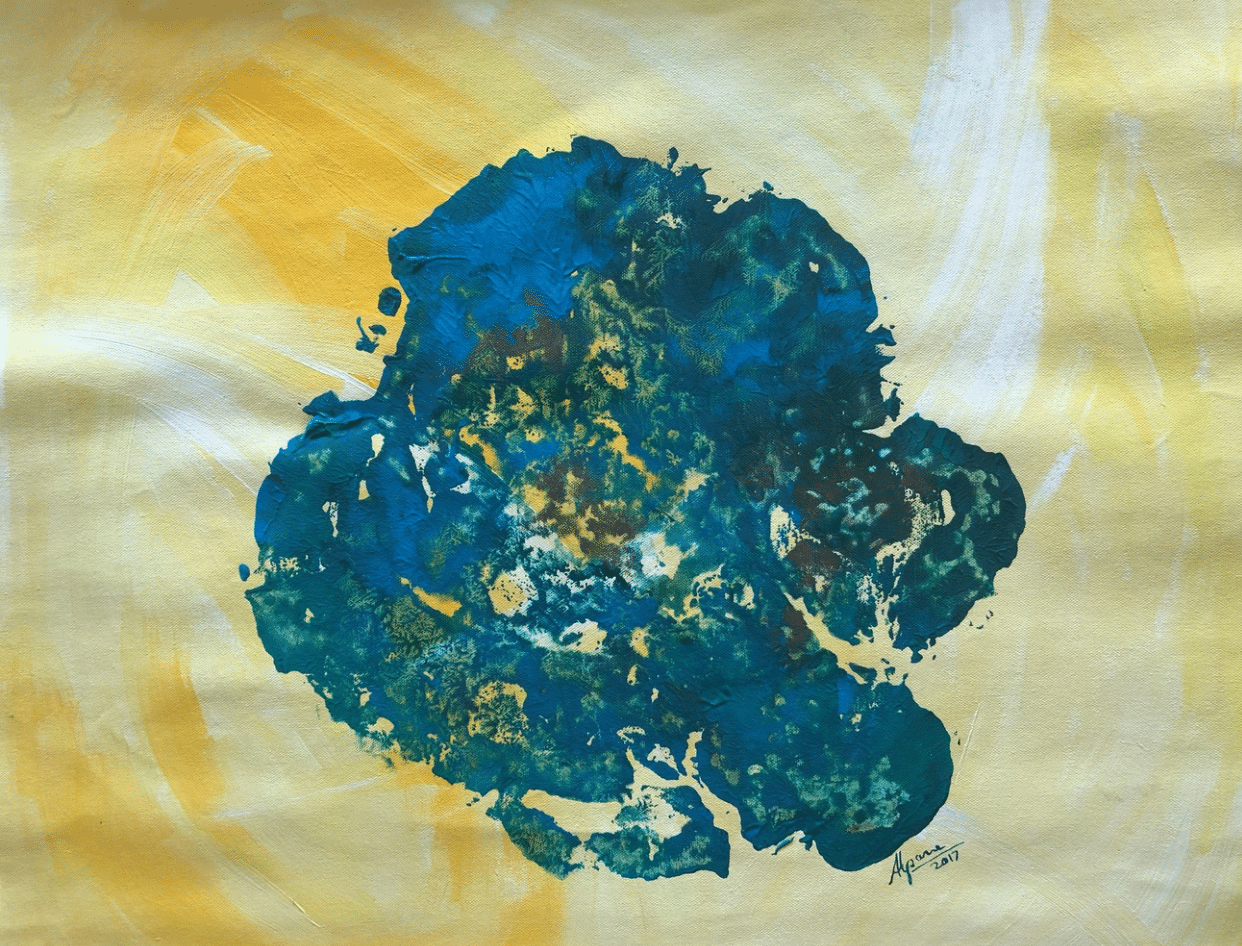
“As they walk they leave behind new life”
In nature, elephants rejuvenate the forests. Their poop contains seeds that pass out undigested and have all the necessary ingredients for saplings to grow. So, as they walk they leave behind new life. Where humans walk…well…it’s total destruction. The life-giving force of Mother Earth is killed forever.
We as humans need to understand that we are just another part of the ecosystem. What makes our part in nature crucial is our ability to choose — we can choose to act in a certain way, to make a change, to make an impact.
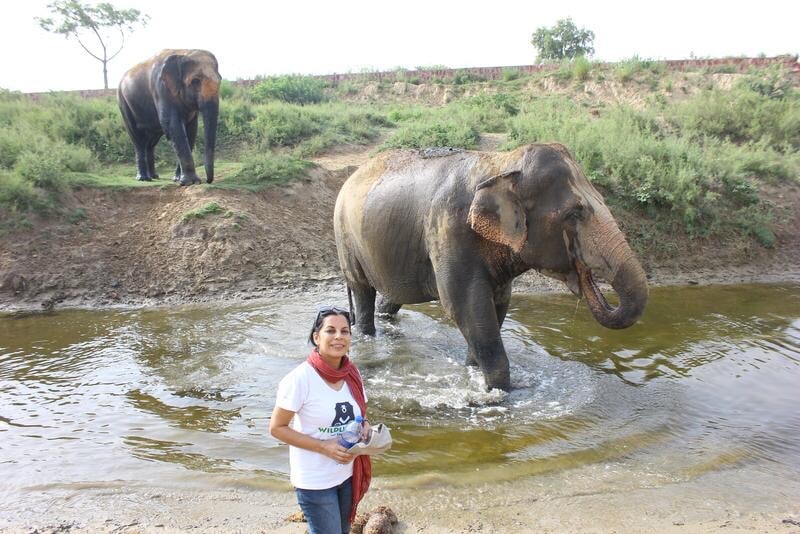
Phoolkali
Could you tell us about Phoolkali, the elephant you mentioned earlier?
She is blind in one eye from abuse before she was rescued. But she is so gentle, calm and always cooperative in our artworks. She understands the process of making the footprints and gives me almost perfect prints each time. She is, however, very attached to her elephant friend Maya and does not like to be away from her for too long. Maya does not really enjoy making foot prints, so we let her do her own thing.
“A city in a garden”
What is the impact you would like your work to have?
I would like people to stop and consider the impact of their actions, whether it’s riding elephants or watching animals perform. Whether it’s deforestation or concretization of Mother Earth. My message is “co-existence” because if we don’t accept it, we are doomed. Once the wildlife perishes, we follow very quickly.
What I like about Singapore, in particular, is that the agencies here are definitely trying to balance the natural and man-made aspects within this island country. The thinking is more about having “a city in a garden” rather than the other way around.
Wildlife Conservation in Singapore
What sort of wildlife conservation goes on in Singapore? We think of it as a highly urbanized place.
Singapore was a rainforest and as the city developed, green spaces were maintained. The effort now is to have corridors connect some of these green spaces for the wildlife to move. Nature groups like ACRES (Animal Concerns Research and Education Society), Nature Society Singapore, Wildlife Reserves, and the government-run NParks work in tandem to conserve, save and protect the wildlife here.
Smooth-coated otters are the most visible wildlife and they have a huge fan following. Tribes of otters move about the city, sometimes using swimming pools as way stations, which is quite amazing to come upon. We have many other creatures: Malayan colugos, pangolins, common palm civets, monitor lizards, long-tailed macaques, many species of snakes, bats and birds. It’s pretty fascinating that the wildlife here is so diverse for a land space as small as this!
“Let’s be more aware and grow more as humans”
What do you want 2020 to be the year of?
More growth, more good work, and more impact! I look at my life now and see how I’ve evolved as a person and artist over the years. From a young girl drawing by herself to now becoming a grandma, I see that all these different life stages have also allowed me to impact others differently. I say to my other friends who are also grandmas, “Raise them young!” Let’s teach our grandchildren and children too, about how we have only one mother: Mother Earth. Let’s give her children, the animals, a voice — because they can’t speak for themselves. Let’s be more aware and grow more as humans too, so that we can start making more of a positive impact on our surroundings.
An Elephant’s Strength
When working with elephants, do you have to take precautions?
They are, of course, huge and strong, so they may be feeling affectionate, but one needs to be careful. Once with Phoolkali, I was giving her a melon. She wrapped her trunk around it, but it slipped out and my arm got yanked up instead! She realized it in a few seconds and dropped me. I was startled and I took a tumble. I was fine, but one needs to be aware of their vast strength.
The tail is another curious problem. The elephants don’t really think too much about it, but if one is behind them, it will hit you in the face. It’s a hard smack that feels like being hit with a toilet brush. But I only got smacked once and was wiser and very careful after that.
This week Alpana is off to Myanmar to a camp to assist an American team who is training veterinarians in Asia how to look after elephants. To become involved, check out Wildlife SOS.
Damini Roy is an independent writer and consultant based in Singapore who focuses on topics of diversity and human experience.
The ideas expressed here are solely the opinions of the author and are not researched or verified by AGEIST LLC, or anyone associated with AGEIST LLC. This material should not be construed as medical advice or recommendation, it is for informational use only. We encourage all readers to discuss with your qualified practitioners the relevance of the application of any of these ideas to your life. The recommendations contained herein are not intended to diagnose, treat, cure or prevent any disease. You should always consult your physician or other qualified health provider before starting any new treatment or stopping any treatment that has been prescribed for you by your physician or other qualified health provider. Please call your doctor or 911 immediately if you think you may have a medical or psychiatric emergency.

